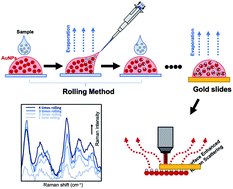当前位置:
X-MOL 学术
›
Anal. Methods
›
论文详情
Our official English website, www.x-mol.net, welcomes your
feedback! (Note: you will need to create a separate account there.)
Development of a facile rolling method to amplify an analyte's weak SERS activity and its application for chlordane detection
Analytical Methods ( IF 2.7 ) Pub Date : 2019/12/11 , DOI: 10.1039/c9ay02140j Yanqi Qu 1, 2, 3, 4 , Lili He 1, 2, 3, 4
Analytical Methods ( IF 2.7 ) Pub Date : 2019/12/11 , DOI: 10.1039/c9ay02140j Yanqi Qu 1, 2, 3, 4 , Lili He 1, 2, 3, 4
Affiliation

|
The surface-enhanced Raman scattering (SERS) technique has been extensively explored as a rapid analytical tool for various pesticides. However, not all pesticides exhibit similar SERS activities; in particular, certain organochloride pesticides, such as chlordane, have relatively weaker SERS signals when interacting with citrate-coated gold nanoparticles. Herein, a simple rolling method was developed to amplify the SERS signal of chlordane and to facilitate its detection in a livestock oil sample. The rolling method was performed by mixing a 2.5 microliter chlordane methanolic solution with a gold nanoparticle solution with a pipette on a piece of parafilm for 20 seconds. Once the half volume size of solvents was evaporated, another 2.5 microliter chlordane solution was added to the mixture and was pipetted for another 20 seconds. This action was continuously repeated to enrich the chlordane concentration, allow a better interaction between chlordane and gold nanoparticles, and achieve Raman signal amplification. For example, for the 2.5 ppm chlordane sample, after four times of rolling, the Raman signals were enhanced by approximately four times. Later on, a mathematic model was established to predict the concentration of chlordane in a complex crude oil sample based on the obtained intensity reading and the number of repeats. Compared to the spiked concentration (i.e., 1 ppm) of chlordane, the recovery value reached 95% approximately. The rolling method is a simple enrichment approach without the need for the use of concentrating instruments. Combined with the prediction model, it can determine the concentration of hard-to-detect analytes in food samples based on the amplification of their weak SERS signals.
中文翻译:

开发一种简便的轧制方法以放大分析物的弱SERS活性及其在氯丹检测中的应用
表面增强拉曼散射(SERS)技术已被广泛探索为各种农药的快速分析工具。但是,并非所有农药都表现出相似的SERS活性。特别是某些有机氯化物农药(例如氯丹)在与柠檬酸盐涂层的金纳米颗粒相互作用时具有相对较弱的SERS信号。在本文中,开发了一种简单的轧制方法以放大氯丹的SERS信号并促进其在牲畜油样品中的检测。通过将2.5微升的氯丹甲醇溶液与金纳米颗粒溶液用移液管在一块石蜡膜上混合20秒来进行轧制方法。一旦蒸发了一半体积的溶剂,就将另外的2.5微升氯丹溶液添加到该混合物中,再移液20秒钟。连续重复此操作,以丰富氯丹的浓度,使氯丹与金纳米颗粒之间具有更好的相互作用,并实现拉曼信号放大。例如,对于2.5 ppm的氯丹样品,经过四次滚动,拉曼信号增强了大约四倍。后来,建立了一个数学模型,根据获得的强度读数和重复次数,预测复杂原油样品中的氯丹浓度。与加标浓度相比(后来,建立了一个数学模型,根据获得的强度读数和重复次数,预测复杂原油样品中的氯丹浓度。与加标浓度相比(后来,建立了一个数学模型,根据获得的强度读数和重复次数,预测复杂原油样品中的氯丹浓度。与加标浓度相比(即1 ppm)的氯丹,回收率大约达到95%。滚动法是一种简单的浓缩方法,不需要使用浓缩仪。结合预测模型,它可以基于弱SERS信号的放大来确定食品样品中难以检测的分析物的浓度。
更新日期:2020-02-13
中文翻译:

开发一种简便的轧制方法以放大分析物的弱SERS活性及其在氯丹检测中的应用
表面增强拉曼散射(SERS)技术已被广泛探索为各种农药的快速分析工具。但是,并非所有农药都表现出相似的SERS活性。特别是某些有机氯化物农药(例如氯丹)在与柠檬酸盐涂层的金纳米颗粒相互作用时具有相对较弱的SERS信号。在本文中,开发了一种简单的轧制方法以放大氯丹的SERS信号并促进其在牲畜油样品中的检测。通过将2.5微升的氯丹甲醇溶液与金纳米颗粒溶液用移液管在一块石蜡膜上混合20秒来进行轧制方法。一旦蒸发了一半体积的溶剂,就将另外的2.5微升氯丹溶液添加到该混合物中,再移液20秒钟。连续重复此操作,以丰富氯丹的浓度,使氯丹与金纳米颗粒之间具有更好的相互作用,并实现拉曼信号放大。例如,对于2.5 ppm的氯丹样品,经过四次滚动,拉曼信号增强了大约四倍。后来,建立了一个数学模型,根据获得的强度读数和重复次数,预测复杂原油样品中的氯丹浓度。与加标浓度相比(后来,建立了一个数学模型,根据获得的强度读数和重复次数,预测复杂原油样品中的氯丹浓度。与加标浓度相比(后来,建立了一个数学模型,根据获得的强度读数和重复次数,预测复杂原油样品中的氯丹浓度。与加标浓度相比(即1 ppm)的氯丹,回收率大约达到95%。滚动法是一种简单的浓缩方法,不需要使用浓缩仪。结合预测模型,它可以基于弱SERS信号的放大来确定食品样品中难以检测的分析物的浓度。











































 京公网安备 11010802027423号
京公网安备 11010802027423号